greenleaf
Senior Member
UrbanToronto meet NoYo.
All parts of Toronto are defined by a neighbourhood, some more aptly named than others. Neighbourhood boundaries can be distinct, or can be blurry and overlap. Some places may be a part of more than one neighbourhood. In the blurry edges of these places lies an opportunity for neighbourhood borders to change and new local communities to emerge.
Neighbourhoods change over time. New immigrants move in. Gentrification happens. Sometimes a place goes into decline. New buildings go up and old buildings are given fresh uses. In some places, as density increases, the size of a neighbourhood can change, even shrink. In a dense city, one block can feel completely different from the next. In places of sprawl, the transition from one neighbourhood to the next can be more subtle (except, perhaps, in places that abut "the other side of the tracks").
With all the new and proposed buildings that have gone up in Toronto in the past 4-5 years, it is not surprising to see places evolve as people identify locations in new ways.
The Toronto Star did a neighbourhood mapping exercise in March 2009 and created a very delineated map of Toronto with hundreds of suggestions from readers. Despite all of this, there are still areas that weren’t part of any identified neighbourhood, including parts of downtown Toronto along Yonge and Bay Streets where tens of thousands of Torontonians live and work.
One of these nameless but evolving places is the area along Yonge Street north of Bloor from the Reference Library to Rosedale Subway Station and Ramsden Park, and extending west to Davenport and Bay.

This area is often referred to as Yorkville. The city officially defines it as part of the Rosedale-Moore Park neighbourhood. The local ratepayers association is known as ABC. Parts of this area blend into Av & Dav and Yonge & Bloor. But what Torontonians picture when we think of these nodes and neighbourhoods doesn’t reflect what is found in this neighbourhood north of Yorkville – NoYo.
NoYo is different from Yorkville. The ground floor retail with mixed office and residential uses above means that the strip of Yonge north of Bloor reflects the grit and variety of Yonge between Bloor and College. The stores here (ranging from myriad home furnishing/renovation stores to hair salons to a tea shop) are complementary but more downscale compared to Yorkville. The neighbourhood's two primary landmarks (for better or worse) are the Masonic Temple, due to its historical nature and as the current home of MTV Canada, and the Canadian Tire, whose street level largess demands recognition by pedestrians and whose central downtown location is convenient and known by those who live outside of the immediate hood.
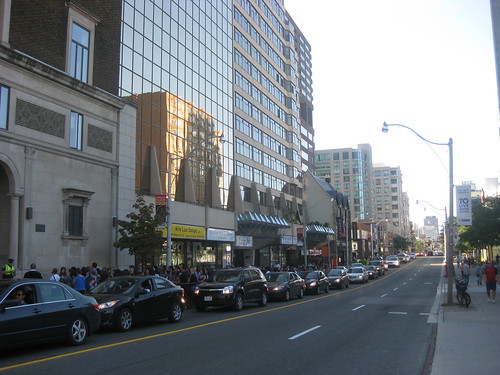
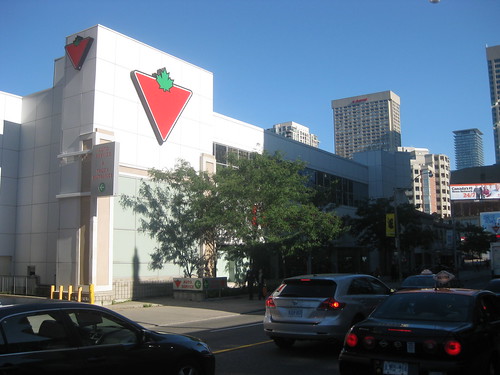

On the north border of NoYo is Ramsden Park, a popular dog walking or strolling location, as well the home of numerous well-used tennis courts. Every neighbourhood needs some good park space.

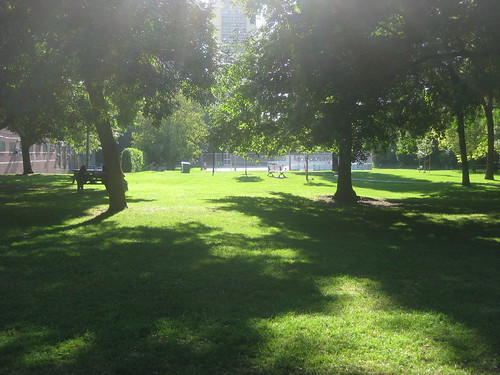
Besides physical differences, what sets NoYo apart from Yorkville or Rosedale are its residents. Behind Yonge Street is a flourishing range of retirement houses, including relatively new condos on the quiet and comfortable McMurrich Street and the popular Belmont House retirement community. These residences seem to appeal to those retirees who want an urban lifestyle without the glitz and glamour (or expensive square footage) associated with Yorkville. While not every resident is a retiree, the age bracket of this enclave definitely skews older.
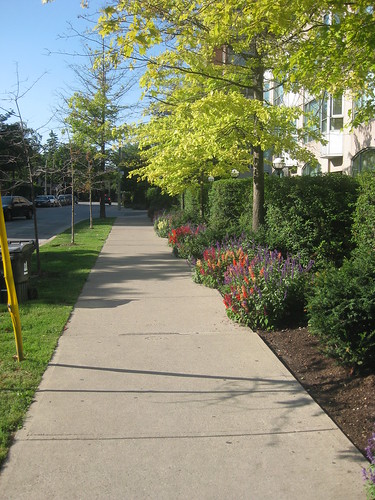
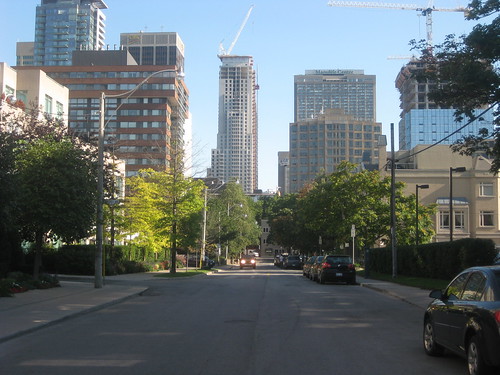
This first wave of condo residents will soon be joined by the residents of the many new developments that are rapidly changing the face of NoYo.
The Lotus condo was completed last year. Out front, the Frank Stollery Parkette will become a new meeting place and another spot to read outdoors after dropping by the Yorkville library.
The Florian condo is currently under construction where Bay Street ends at Davenport Road.
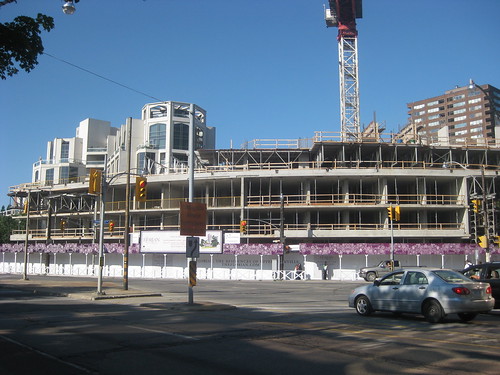
Immediately east of the Florian is the proposed Yorkville Condominiums, a 31-story condo.
Demolition of the parking lot on the site of Milan Condo at the intersection of Yonge & Church has slowed to crawl, but work is continuing. Hoarding is expected to go up in the next month. Communication with the TTC is certainly important here, considering the subway line runs on the eastern part of the property.
Two new towers (including a hotel) are scheduled to be built on the current site of Ridpath's Furniture on Yonge, north of Davenport. This development site is slim but deep, running from Yonge to McMurrich.
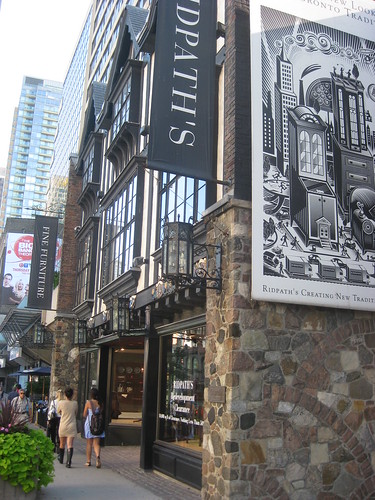
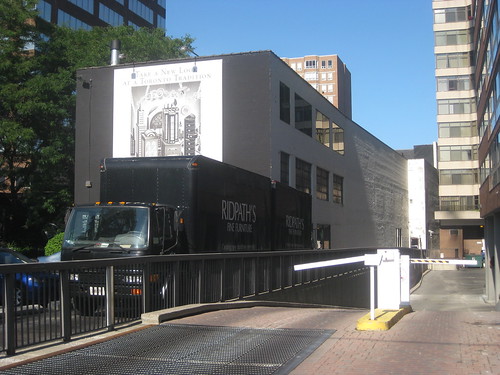
Finally, an application was made in July for a new condo of undetermined height at 901 Yonge Street, near the opposite side where Frichot Avenue terminates on Yonge.

What is next for NoYo? Following these developments, there are few remaining places to build up (without tearing medium-sized buildings down) in this community. The Canadian Tire site may be an option sometime in the future. The lovely Belmont Street and Hillsboro Avenue are full of charming townhouses, many of which are quite old and heritage protected.

What is needed in NoYo? Primarily, the neighbourhood is lacking a good medium sized grocer. The benches outside of Fellowship Towers (north of Canadian Tire) are well-used, providing eyes on the street and an informal meeting place for those in the building. More benches like these could increase that dynamic.

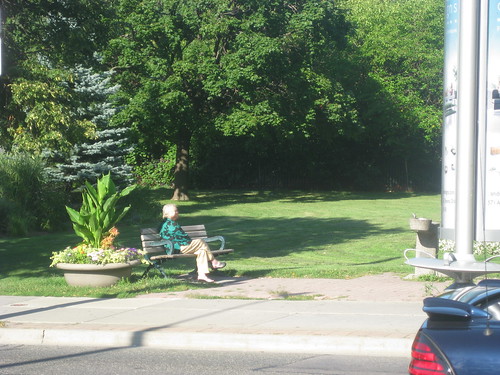
Earlier this summer, this New York Times article noted several initiatives completed by New York City to assist the quality of life of its elderly, including adding more benches, increasing crossing time at crosswalks, and creating rental space for artists in exchange for offering art classes to seniors. Perhaps NoYo is the appropriate area for Toronto to think about a similar approach.
As part of their Urban Voters Series, on Wednesday, September 15th at 7 pm, the Toronto Reference Library will be hosting a discussion on this topic titled Urban Voters Series: Ageing in the City with Glen Murray, current MPP for Toronto Centre and Jane Barratt from the International Federation on Ageing.
Development Thread Links:
The Lotus and Frank Stollery Parkette
Milan Residences
The Florian
The Yorkville Condominiums
906 Yonge St condo/hotel
901 Yonge St
All parts of Toronto are defined by a neighbourhood, some more aptly named than others. Neighbourhood boundaries can be distinct, or can be blurry and overlap. Some places may be a part of more than one neighbourhood. In the blurry edges of these places lies an opportunity for neighbourhood borders to change and new local communities to emerge.
Neighbourhoods change over time. New immigrants move in. Gentrification happens. Sometimes a place goes into decline. New buildings go up and old buildings are given fresh uses. In some places, as density increases, the size of a neighbourhood can change, even shrink. In a dense city, one block can feel completely different from the next. In places of sprawl, the transition from one neighbourhood to the next can be more subtle (except, perhaps, in places that abut "the other side of the tracks").
With all the new and proposed buildings that have gone up in Toronto in the past 4-5 years, it is not surprising to see places evolve as people identify locations in new ways.
The Toronto Star did a neighbourhood mapping exercise in March 2009 and created a very delineated map of Toronto with hundreds of suggestions from readers. Despite all of this, there are still areas that weren’t part of any identified neighbourhood, including parts of downtown Toronto along Yonge and Bay Streets where tens of thousands of Torontonians live and work.
One of these nameless but evolving places is the area along Yonge Street north of Bloor from the Reference Library to Rosedale Subway Station and Ramsden Park, and extending west to Davenport and Bay.

This area is often referred to as Yorkville. The city officially defines it as part of the Rosedale-Moore Park neighbourhood. The local ratepayers association is known as ABC. Parts of this area blend into Av & Dav and Yonge & Bloor. But what Torontonians picture when we think of these nodes and neighbourhoods doesn’t reflect what is found in this neighbourhood north of Yorkville – NoYo.
NoYo is different from Yorkville. The ground floor retail with mixed office and residential uses above means that the strip of Yonge north of Bloor reflects the grit and variety of Yonge between Bloor and College. The stores here (ranging from myriad home furnishing/renovation stores to hair salons to a tea shop) are complementary but more downscale compared to Yorkville. The neighbourhood's two primary landmarks (for better or worse) are the Masonic Temple, due to its historical nature and as the current home of MTV Canada, and the Canadian Tire, whose street level largess demands recognition by pedestrians and whose central downtown location is convenient and known by those who live outside of the immediate hood.



On the north border of NoYo is Ramsden Park, a popular dog walking or strolling location, as well the home of numerous well-used tennis courts. Every neighbourhood needs some good park space.


Besides physical differences, what sets NoYo apart from Yorkville or Rosedale are its residents. Behind Yonge Street is a flourishing range of retirement houses, including relatively new condos on the quiet and comfortable McMurrich Street and the popular Belmont House retirement community. These residences seem to appeal to those retirees who want an urban lifestyle without the glitz and glamour (or expensive square footage) associated with Yorkville. While not every resident is a retiree, the age bracket of this enclave definitely skews older.


This first wave of condo residents will soon be joined by the residents of the many new developments that are rapidly changing the face of NoYo.
The Lotus condo was completed last year. Out front, the Frank Stollery Parkette will become a new meeting place and another spot to read outdoors after dropping by the Yorkville library.
The Florian condo is currently under construction where Bay Street ends at Davenport Road.

Immediately east of the Florian is the proposed Yorkville Condominiums, a 31-story condo.
Demolition of the parking lot on the site of Milan Condo at the intersection of Yonge & Church has slowed to crawl, but work is continuing. Hoarding is expected to go up in the next month. Communication with the TTC is certainly important here, considering the subway line runs on the eastern part of the property.
Two new towers (including a hotel) are scheduled to be built on the current site of Ridpath's Furniture on Yonge, north of Davenport. This development site is slim but deep, running from Yonge to McMurrich.


Finally, an application was made in July for a new condo of undetermined height at 901 Yonge Street, near the opposite side where Frichot Avenue terminates on Yonge.

What is next for NoYo? Following these developments, there are few remaining places to build up (without tearing medium-sized buildings down) in this community. The Canadian Tire site may be an option sometime in the future. The lovely Belmont Street and Hillsboro Avenue are full of charming townhouses, many of which are quite old and heritage protected.

What is needed in NoYo? Primarily, the neighbourhood is lacking a good medium sized grocer. The benches outside of Fellowship Towers (north of Canadian Tire) are well-used, providing eyes on the street and an informal meeting place for those in the building. More benches like these could increase that dynamic.


Earlier this summer, this New York Times article noted several initiatives completed by New York City to assist the quality of life of its elderly, including adding more benches, increasing crossing time at crosswalks, and creating rental space for artists in exchange for offering art classes to seniors. Perhaps NoYo is the appropriate area for Toronto to think about a similar approach.
As part of their Urban Voters Series, on Wednesday, September 15th at 7 pm, the Toronto Reference Library will be hosting a discussion on this topic titled Urban Voters Series: Ageing in the City with Glen Murray, current MPP for Toronto Centre and Jane Barratt from the International Federation on Ageing.
Development Thread Links:
The Lotus and Frank Stollery Parkette
Milan Residences
The Florian
The Yorkville Condominiums
906 Yonge St condo/hotel
901 Yonge St
Last edited:





